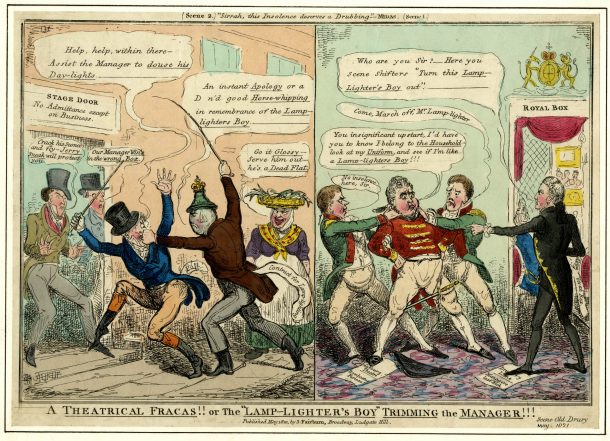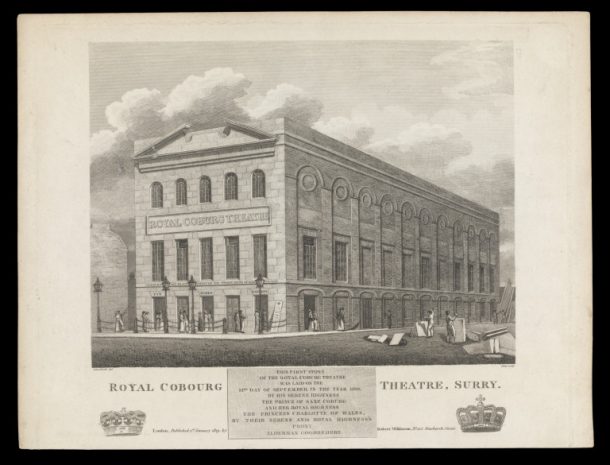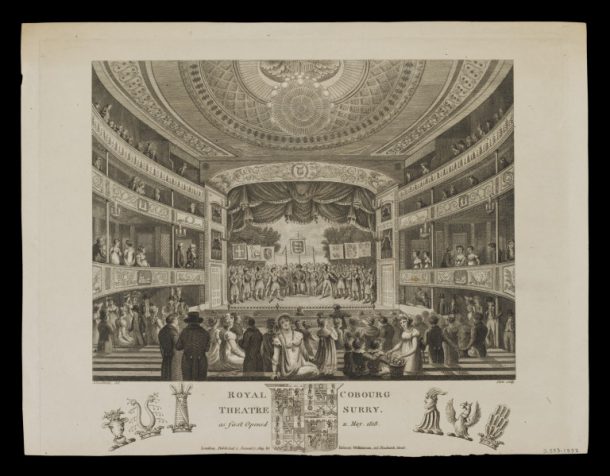To mark the 200th anniversary of the Old Vic, guest blogger Pieter van der Merwe shares the story of one of the theatre’s first managers.

The ‘Old Vic’ has just celebrated the 200th anniversary of its opening in 1818. In February this year, announcing preparations for this, the current artistic director Matthew Warchus said his aim was not to eulogise the theatre as a ‘historic artefact’ but a place ‘characterised by mischief, populism, sometimes breath-taking boldness and risk.’ That tradition started with his earliest predecessor but probably not how he meant….
The ‘Vic’ was originally the Royal Coburg Theatre, named to honour the marriage of the short-lived Princess Charlotte (daughter of the Prince Regent, later George IV) to Leopold of Saxe-Coburg, future King of the Belgians. Construction began in then-rural Lambeth in 1816 but faltered until Francis Glossop, a wealthy Soho wax and tallow chandler, became involved. As a supplier of lighting for theatres, he had ‘imbibed the theatrical mania’ but his fifth and youngest son, Joseph (b.1793), caught the stage bug even worse. With family money Joseph completed and opened the theatre as its first manager on 11 May 1818, to early popular success, with an output of musical melodrama and spectacular action pieces. Young Joseph’s ambition was boundless: Glossop cash quickly bought out the other two main Coburg shareholders for £3000 each (about £180,000 today) one being its scenic director, the marine painter J.T. Serres, who had also lavishly decorated its grand Marine Saloon. By 1821, based on the house’s tenuous royal connection, Joseph had also become Clerk of the Cheque to the Gentleman Pensioners, allegedly as part of scheme to get a knighthood from George IV, and had taken on two more theatres. In 1819, he staged the first-ever winter season at Astley’s Amphitheatre, the popular horse-circus just south of Westminster Bridge (now under part of St Thomas’s Hospital), then in 1821 leased the old Royalty Theatre in Wellclose Square, Stepney, but almost as fast had to give up both places, claiming a combined loss of £2,800. In 1822, at further huge expense, he boosted novelty at the Coburg by importing from Paris a mirror-glass drop-curtain in which the audience could admire itself (‘That’s all werry well’, yelled someone in the gallery, ‘now show us summut else!’), but in November fled to the Continent ahead of arrest for forgery, probably of a financial document.

While that ended his first Coburg stint, by late 1823 ‘il Cavaliere Glossop’ had materialised at both Milan and Naples, where his grandiose plausibility won him control of the two largest opera houses in Italy, La Scala and the San Carlo. This was part of a new project to establish his wife, Elizabeth Feron, – a talented soprano sometimes called ‘the English Catalani’– as an Italian prima donna. They already had two daughters, but by the time their son Augustus was born at Naples in June 1825, ‘il Cavaliere’ was also being evicted from both Italian managements with losses later reported as £200,000. He and Elizabeth separated shortly afterwards and she continued a successful independent career, starting with a period in America from 1828. Even before she sailed however – calling himself ‘Gapper’ Glossop (his mother’s maiden name) and a bachelor – Joseph bigamously married in 1827 at Livorno to Joséphine de Méric, a French soprano whose talents he began promoting around Europe. Their daughter Emilie (later also a singer) was born in Paris in 1830 but this marriage also quickly disintegrated. In March 1833, back in London, Glossop was declared bankrupt with debts of some £56,000, mainly accrued at the Coburg, which was renamed the ‘Royal Victoria’ later that year after a visit by the future Queen. He nonetheless still managed to reinstall himself as its manager, lavishly renovating and reopening it in September 1834 with usual panache and another mirror-glass drop curtain, but unpaid bills again soon piled up. In March 1835 his credit finally ran out when his father Francis died, leaving his eldest brother – the highly respected Revd Henry Glossop, vicar of Isleworth – as head of the family. Joseph was again made bankrupt but still managed to retain a small interest at the ‘Vic’, though his father’s will expressly lamented the expense, ‘torment and misery’ his youngest son had brought on him. From the grave, Francis urged that he receive no more than £2 a week further income from family funds, plus any surplus accruing from their interest as landlords of the ‘Vic’. Joseph was last spotted running a boarding house in Brussels in 1842, and just ‘as happy as when managing the Coburg and the San Carlo’. Like other economising remittance-men, he later moved to Florence, where he died in November 1850 and was buried – as ‘Joseph Buggles Glossop’ – in the English cemetery.
This trail of ruin and scandal is glossed out of Burke’s Landed Gentry (into which the Glossops graduated from ‘trade’ by the 1890s) and ended more happily in Joseph’s children. Both his elder daughters were musical. Frances briefly sang as a pupil of the celebrated tenor John Braham: Mary Ann was a successful composer of popular songs and operas, with libretti by her also well-known husband, the lawyer and humorous writer Gilbert Abbott à Beckett. From 1851 their actor brother re-branded himself ‘Augustus Harris’ and became a successful international theatre manager with a long link to Covent Garden. His son, in turn, was the impresario Sir Augustus Henry Glossop Harris, who, at his death aged 44 in 1896 the critic William Archer considered ‘the greatest showman… that England has ever produced.’ Called ‘Druriolanus’ from his spectacular management of the Theatre Royal, Drury Lane (and jointly of Covent Garden), his bust still looks out from its entrance facade on Catherine Street, though his knighthood was a civic rather than theatrical honour.

If the ‘Old Vic’ has a ghost it ought to be Joseph Glossop. It is his monument, as well as London’s second-oldest theatre after Drury Lane and the first home of the National Theatre (1963–76). In its 200th year it would at least be good to find a decent portrait of him: the only one known seems to be as ‘the Lamp-Lighter’s Boy’ in a caricature by Robert Cruikshank. He deserves better memory: without him, there would be no bicentenary to celebrate.
Visit the Theatre and Performance Galleries to discover a display celebrating the Old Vic, on until December 2018.


